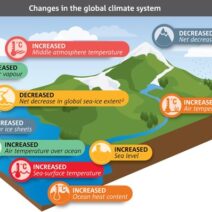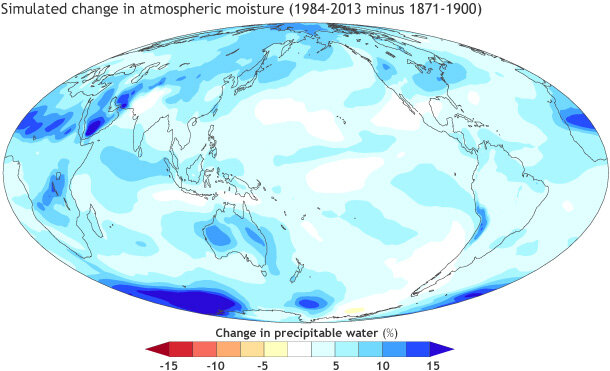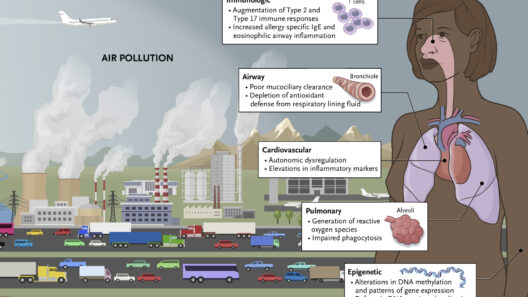Global warming has emerged as one of the most pressing issues of our time, with multifaceted implications for the environment. Among the myriad effects, one of the most intricate yet vital aspects to understand is the impact of global warming on atmospheric moisture. Often overlooked in discussions surrounding climate change, the significance of moisture in the atmosphere cannot be overstated. This article delves into the nuances of how rising temperatures influence atmospheric moisture, unraveling the interconnected web between global warming, weather patterns, and ecological systems.
To begin with, it is imperative to comprehend what atmospheric moisture is. Essentially, atmospheric moisture, or humidity, refers to the presence of water vapor in the atmosphere. It plays a critical role in regulating the Earth’s climate, influencing weather patterns, and supporting the water cycle. As temperatures rise, the capacity of air to hold moisture increases. According to the Clausius-Clapeyron equation, for every one degree Celsius increase in temperature, the atmosphere can hold approximately 7% more moisture. This increase in water vapor, while contributing to various phenomena, also underpins a host of environmental challenges.
The first major consequence of increased atmospheric moisture is the intensification of precipitation events. As the atmosphere warms and holds more moisture, it leads to heavier rainfall and more severe storms. The relationship between global warming and precipitation patterns is complex. While some regions may experience increased rainfall, others may suffer from droughts. This paradox arises because some areas become saturated while nearby locations remain arid. Such discrepancies can induce ecological turmoil, as ecosystems struggle to adapt to rapidly changing water availability.
Additionally, the phenomenon of increased atmospheric moisture contributes to the frequency and severity of extreme weather events. Hurricanes, for instance, derive their energy from warm ocean waters and abundant atmospheric moisture. As ocean temperatures rise, storms can gather strength, leading to catastrophic impacts on coastal ecosystems and communities. This connection illustrates the interplay between global warming and natural disasters, accentuating the need for robust climate action to mitigate these risks.
Moreover, the rise in atmospheric moisture can exacerbate the already virulent effects of climate change on biodiversity. Altered precipitation patterns can disrupt habitats, affecting flora and fauna that are sensitive to specific moisture levels. Many species rely on a predictable water supply for survival, and fluctuations can render their environments inhospitable. Furthermore, increased humidity can favor the proliferation of invasive species and pests, which can outcompete native organisms and destabilize ecosystems. This cascading effect further complicates the struggle for ecological balance in a warming world.
On a broader scale, increased atmospheric moisture can influence global climate patterns, including shifting the locations of climate zones. As moisture levels change, areas that were once temperate may become subtropical, and previously arid regions may experience increased humidity. This shift can have significant implications for agriculture, water resources, and human habitation. For instance, farmers may find it increasingly difficult to predict the timing of rains, which can hamper crop yields and threaten food security.
Furthermore, the intertwining of atmospheric moisture with the global water cycle cannot be overlooked. The water cycle is an intricate system where water evaporates from the earth’s surface, condenses into clouds, and eventually precipitates back to the ground. Global warming alters this cycle, leading to increased evaporation rates from oceans, lakes, and rivers. Consequently, this can enhance the likelihood of droughts in certain areas, while simultaneously increasing flooding risks in others. Such variability can create a landscape of extremes that is detrimental to both natural and human systems.
A concerning aspect related to increased atmospheric moisture is its role in amplifying the greenhouse effect. Water vapor is considered a potent greenhouse gas. As temperatures increase, more water vapor enters the atmosphere, leading to enhanced greenhouse warming. This feedback loop creates challenging circumstances in our efforts to combat climate change, as higher temperatures lead to more moisture, which in turn leads to even higher temperatures. Addressing global warming thus becomes increasingly urgent as the ramifications of moisture dynamics gain prominence in climate models.
Moreover, urban areas are particularly vulnerable to the complexities introduced by rising atmospheric moisture. Urbanization enhances the heat island effect, leading to higher temperatures in cities. Coupled with increased humidity, urban resilience is challenged as heatwaves amplify health risks, especially for vulnerable populations. Effective urban planning and infrastructure improvements will be essential to counteract these intensifying challenges, ensuring that cities can adapt to, and mitigate, the repercussions of climate change.
In conclusion, the impacts of global warming on atmospheric moisture are profound and multifaceted. The hidden dynamics of moisture in the air influence weather patterns, increase the frequency of extreme events, and disrupt ecological and agricultural systems. As this phenomenon unfolds, it is critical for stakeholders at all levels to recognize the complex interdependencies at play. Awareness and proactive measures will be paramount in addressing the myriad challenges posed by climate change. Only through concerted efforts can society hope to navigate the turbulent waters of a warming world and forge a sustainable path forward.








